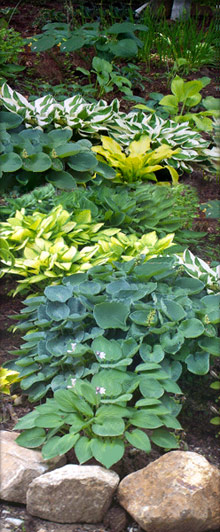• New Hampshire Planting Tips •
New Hampshire soil is typically very shallow with little organic matter, mainly because it was carried away by glaciers thousands of years ago. Because your gardens and plants are an investment, it is important for you to prepare your garden beds and treat your soil before you do any planting.
Preparing your Garden Bed
 Start by clearing the area of rocks, tree roots and weeds. Rototilling will help to loosen the soil. You will need to improve the soil if there is too much clay or sand. Do this by adding organic matter/compost, peat moss or bark mulch. You may even have to add some loam. Loam is usually mixed with sand, and this helps with drainage.
Start by clearing the area of rocks, tree roots and weeds. Rototilling will help to loosen the soil. You will need to improve the soil if there is too much clay or sand. Do this by adding organic matter/compost, peat moss or bark mulch. You may even have to add some loam. Loam is usually mixed with sand, and this helps with drainage.
Our plants contain a slow-release fertilizer, but it is important to add additional fertilizer. Rake a general-purpose fertilizer into the soil before planting.
Soil pH in New Hampshire
The pH of your soil is very important for your plants to take up nutrients, such as phosphorus and potassium. A pH of 4 is acidic, 7 is neutral, and 8 is alkaline. Most plants grow best with a pH between 5.5 and 6.5. Most of the soil in New Hampshire is very acidic, mainly due to the rock content. If the pH of your soil is below 5.5, add lime; if the pH is over 7.0, add peat moss or other organic matter.
Getting Ready to Plant
When your soil is ready, start planting! Remove the plant from its container and loosen the roots at the bottom. Dig a hole so that the plant will be at the same depth as it was in the container. Water thoroughly, and then mulch. Make sure the mulch is loose around the base of the plant. In hot weather, it is important to water 2 to 3 times per week for at least a month until the plant becomes established.
Maintenance is very important! Keep up with pesky weeds (mulch will help to keep down the weed population). Water deeply 1-2 weeks, depending on the soil type and temperatures. Cut back plants in late fall and mulch over for winter protection.
Helpful Links
Our Suppliers
- Vermont Natural Ag Products
Organic compost made in Vermont - Proven Winners
- Bailey Nurseries
Reference/Education
Inspiration
